Consistency in power transmission to the escapement through the fusee.
Many early key-wound watch movements used fusee's, to improve timekeeping. The fusee is a conical pulley attached by a chain to the mainspring barrel. When the spring is fully wound (and its torque the highest), the full length of the chain is wrapped around the fusee and the force of the mainspring is exerted on the smallest diameter portion of the cone. As the spring unwinds and its torque decreases, the chain winds back onto the mainspring barrel and pulls on an increasingly larger diameter portion of the fusee.
Diagrams of the tool used to cut a fusee dating back to the 18th century.
The early form of carbon steel mainspring.
A modern ‘S’ form mainspring, specifically design to ensure more consistent delivery of power through the going train made from modern alloys.
The two fusee’s below have cones far less inclined compared to the Breguet pocket watches above, the variation in torque transmitted by modern mainsprings is far more even than those early ones made in carbon steel.
-Coming soon-
The Naked Watchmaker Masterclass
"Understanding Watchmaking, The Beginning Of A Journey" Subscribe for updates.
Content includes: The Evolution Of Watchmaking, Understanding How A Watch Works. Precision Time-keeping, Movement Decoration, Introducing Complications







